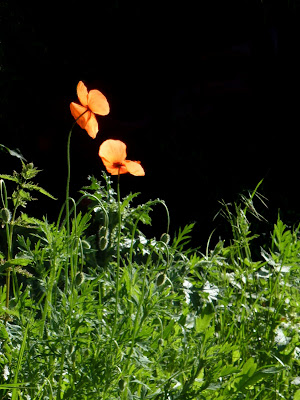This week is "Whitsuntide". Today is Whit Monday, though in the UK this may easily have passed you by. It always used to be a public holiday but in recent years the Spring Bank Holiday, as it's now known, has not co-incided with Whitsun and the old holiday is almost forgotten and certainly rather neglected.
It was once celebrated in a number of different ways in various parts of the country, often involving a deal of singing and dancing - both of which often proved to be thirsty work! In case you feel moved to song, here are the words to "The Whitsuntide Carol"
Now Whitsuntide is come you very well do know,
Come serve the Lord we must before we do go.
Come serve him truly with all your might and heart
And then from heaven your soul shall never depart.
How do you know how long we have to live?
For when we die oh then what would we give?
For being sure of having our resting place
When we have run our sinful wretched race.
Down in those gardens where flowers grow in ranks,
Down on your knees and to the Lord give thanks.
Down on your knees and pray both night and day,
Pray unto the Lord that He will lead the way.
Come all those little children all in the streets we meet
All in their pastimes so even and complete
It's how you may hear them lie, boast, curse and swear
Before that they do know one word of any prayer.
Now we have brought you all this royal branch of oak,
God bless our Queen Victoria and all the royal folk
God bless our Queen and all this world beside
That the Lord may bless you all this merry Whitsuntide.
The song was collected many years ago from one Thomas Coningsby of Whaddon, which is just a couple of miles from where I live. If you want to hear the tune, it was recorded by Peter Bellamy's Young Tradition back in the 1960s in typical uncompromising style. This link will take you there http://www.youtube.com/watch?v=CSK50_di5lo.
Whaddon Church
It is reported that Mr Coningsby recalled that on Whit Monday the men of the village went to the wood to cut oak boughs which they brought back to the village and laid on the doorsteps. They then went around the village as a group singing the carol.
The words of the carol have a very Victorian feel to them. Quite apart from the reference to Victoria herself, the high moral tone is more typical of the 19th century than older times. My suspicion is that it's been got at by some Victorian clergyman, possibly the vicar of Whaddon. Many of the old songs were collected by rural vicars; they were educated men, of course, who had contact with people from all walks of life, they often had a musical education and also had time to undertake the task.
Unfortunately, in the spirit of the age, they often thought they could 'improve' the old songs, so words were tidied up, all bawdy references were removed and they tunes were sometimes changed from the old modal melodies to something which sounded better to their ears. But without their efforts many songs would have been lost forever.
The old tradition was revived recently in Whaddon village, complete with Morris dancers, though I saw no evidence on my visit to suggest that it was going to take place this Whitsuntide. Lets hope that I'm wrong!
Take care.



























































